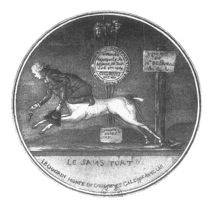 By Laura Auricchio (Guest Contributor)
By Laura Auricchio (Guest Contributor)
The Marquis de Lafayette, French hero of the American Revolution, was a man of many names. In 1757, a rural curate honored a host of heavenly saints and earthly ancestors by baptizing him Marie-Joseph Paul Yves Roch Gilbert du Motier de La Fayette. From the 1770s through the 1830s, grateful Americans came to know him as the Hero of Two Worlds, the Apostle of Liberty, or – in affectionate shorthand – simply The Marquis. During the French Revolution, though, less flattering nicknames accrued to Lafayette. Royalists denounced him as a traitor; radicals termed him a coward; and, in 1791, at least one caricaturist friendly to the monarchy depicted Lafayette as a centaur – a monstrous man-horse hybrid.
On one hand, the caricature mocks Lafayette’s uncommon attachment to his steed. From July 1789 to July 1791, Lafayette cut a conspicuously equestrian figure on the streets of Paris. As Commander of the National Guard, he was so often seen atop a majestic white horse that newspapers and gossip sheets described man and beast as inseparable. According to some reports, the two fused so thoroughly in the popular imagination that at one event in 1790s Lafayette’s admirers nearly smothered both man and mount with warm embraces.
But in eighteenth-century France, where every learned man knew his Greek mythology, picturing Lafayette as a centaur implied something darker. Centaurs were dangerous beings whose base and disorderly natures threatened the very foundations of civilization. So, the caricature implies, was Lafayette, seen here galloping past the severed heads of royalists.
Staunch monarchists held Lafayette responsible for the downfall of Louis XVI, but Lafayette, who wanted to reform, not abolish, the Bourbon throne, considered himself blameless. “The Blameless One” – Le Sans Tort – is the title of the caricature. It is no coincidence that, in French, “Le Sans Tort” sounds precisely like “the centaur.”
 Laura Auricchio is Associate Professor of Art History and Dean of the School of Undergraduate Studies at The New School for Public Engagement. Her newest book The Marquis: Lafayette Reconsidered offers a visually-informed biography on the Marquis de Lafayette.
Laura Auricchio is Associate Professor of Art History and Dean of the School of Undergraduate Studies at The New School for Public Engagement. Her newest book The Marquis: Lafayette Reconsidered offers a visually-informed biography on the Marquis de Lafayette.
